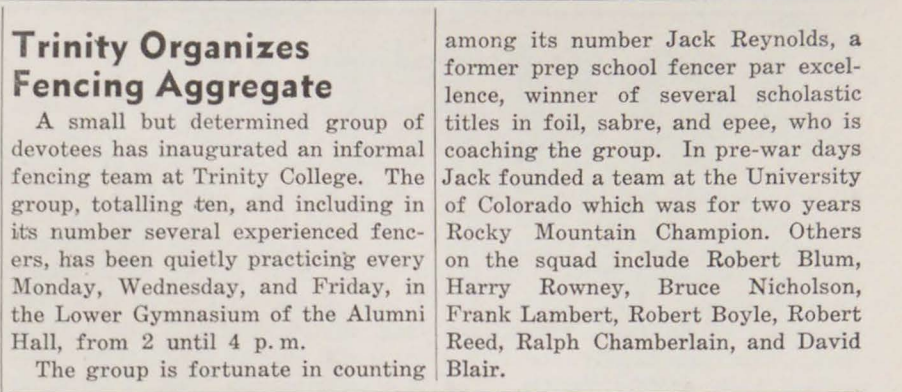Kip Lynch ’22
News Editor
Fencing’s earliest history begins in Spain, where numerous texts were written by Spanish fencers during the 15th century. Modern fencing traces its roots to the 18th century Italian and French schools that replaced the declining Spanish school. Its shift from military training to sport was led by the Italian Domenico Angelo, who established a fencing academy in Carlisle House in Soho, London.
Patronized by the Earl of Pembroke and the dowager Princess of Wales, he taught the Prince of Wales, later King George III, and his brother Prince Edward, Duke of York and Albany. While preparing students for combat, Angelo also emphasized the health benefits of fencing beyond its narrow use as an art of war.
Conventions were set down during the 1880s by the French Camille Prévost. Fencing associations appeared not long after with the foundation of the Amateur Fencers League of America in 1891 and the Amateur Fencing Association of Great Britain in 1902. The sport was also an event in the Olympic Games beginning in 1896. Modern equipment, such as electric scoring boxes, began to be used as early as the 1930s. There are three disciplines in fencing: the foil, épée, and the sabre. Both the foil and the épée are derived from the French small sword while the sabre is derived from the heavier swords typically used by cavalry.
Fencing is only briefly mentioned in Glenn Weaver’s venerable The History of Trinity College, where he describes how the gymnasium built in December 1871 was used: “Perhaps the greatest obstacle to the gymnasium’s use was that the building was not heated in winter, but this did not prevent the organizing of short-lived Fencing and Boxing Teams.”
Following that reference, it is unclear if there was a team, though some Trinity students briefly had “an exhibition of fencing in the gymnasium” by Lieutenant J. Marczi de Zoldy in December 1904.”
There is no mention of fencing in Peter Knapp’s Trinity College in the Twentieth Century: A History, and a fencing club or team is not mentioned in The Trinity Tripod until Feb. 11, 1948, where an article noted that “A small but determined group of devotees has inaugurated an informal fencing team at Trinity College.” This occasion was soon memorialized by Tripod writer Dick Avitabile in the Mar. 3 issue of the same year, who indicated that “At least Trinity has come up with an athletic squad able to defeat Wesleyan!”

The club would continue through the 1950s uncoached, defeating Clark University and Wesleyan University along the way. It would also participate in the National Intercollegiate Fencing Championships in 1952. A decade later, Trinity would finish 22nd out of 36 schools in the NCAA Fencing Championships held at Ohio State University. The Harvard Crimson took a less favorable view of Trinity’s team at the time, with a Harvard student asserting in 1959 that they “were almost certain to win,” despite dispatching their “B-squad against colleges which have a weaker fencing program.” This, of course, could certainly be attributed to a certain, perhaps misplaced Ivy-superiority complex.
Notable victories of the decade include defeating the College of the Holy Cross 23-4. The club finally received a coach in 1968 with the addition of Gerald Pring, who learned fencing at Blackrock College in Dublin, Ireland and founded the Kenya Sword Club in Africa.
Unfortunately, he was forced to quit by the College in the early 1970s after being paid only $200 and was not reimbursed for his monetary contributions to the team, including purchasing electrical equipment for fencing matches. Nevertheless, the club would go on to defeat Norwich University and Northeastern within the next two years.
Although it’s unclear when the women’s fencing team was formed, it would attempt to qualify as a varsity sport in 1984 after being forced to fence with high school teams because of its amateur status. In a Dec. 4, 1984 issue of the Tripod, the SGA Athletic Committee expressed that it was unlikely given the expensive equipment, the need for a full-time instructor, and the probability that the club would fold within a few years. The fencing club would continue to compete through the late 1980s, though with little mention in Trinity publications. It’s unclear whether the club continued to exist through the 1990s.
As for the 21st century, the fencing team is only briefly mentioned in passing in the Tripod upon approval of its budget by the Student Government Association in 2005. The Hartford Courant also made mention of a 2012 “Trinity College Fencing Classic,” hosting students from Wesleyan, Amherst, UConn, and others at Ferris Athletic Center. Trinity, however, was not listed among the victors.
I assumed leadership of the Trinity College Fencing Club in the fall of my sophomore year and worked to build up the roster and purchase new equipment. However, the club was only able to meet once during the following semester before the College moved classes online after spring break.
Although I have thus far avoided advertising the club with the intention of keeping the club centered around a close group of amateurs, the club is open to anyone regardless of experience. I only received lessons when I was younger and hadn’t fenced for 13 years until I arrived at Trinity.
If you are interested in joining the club, please contact me at seamus.lynch@trincoll.edu.







Rick Dubiel: If you look in the trophy case at Ferris, there are two fencing trophies. The dates on the trophies would document the activity of the club. I was an active fencer from 1973-1977. We were coached by former Olympian Ralph Spinella from Waterbury CT, who placed 3rd in epee.